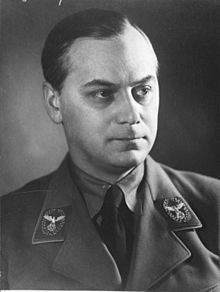Alfred Rosenberg | |
|---|---|
 Rosenberg in 1939 | |
| Leader of the Foreign Policy Office of the NSDAP | |
| In office 1 April 1933 – 8 May 1945 | |
| Preceded by | Position established |
| Succeeded by | Position abolished |
| Reichsleiter | |
| In office 2 June 1933 – 8 May 1945 | |
| Führer's Representative for the Supervision of Intellectual and Ideological Education of the NSDAP ("Rosenberg Office") | |
| In office 27 January 1934 – 8 May 1945 | |
| Preceded by | Position established |
| Succeeded by | Position abolished |
| Reich Minister for the Occupied Eastern Territories | |
| In office 17 July 1941 – 8 May 1945 | |
| Führer | Adolf Hitler |
| Preceded by | Position established |
| Succeeded by | Position abolished |
| Personal details | |
| Born | Alfred Ernst Rosenberg 12 January [O.S. 31 December 1892] 1893 Reval, Governorate of Estonia, Russian Empire (present-day Tallinn, Estonia) |
| Died | 16 October 1946 (aged 53) Nuremberg Prison, Nuremberg, Bavaria, Allied-occupied Germany |
| Cause of death | Execution by hanging |
| Nationality | Baltic German |
| Political party | Nazi Party |
| Spouses | Hilda Leesmann
(m. 1915; div. 1923)Hedwig Kramer
(m. 1925) |
| Children | 2 |
| Education | Engineering |
| Alma mater | Riga Polytechnical Institute Moscow Highest Technical School |
| Profession | Architect, politician, writer |
| Known for | Authoring The Myth of the Twentieth Century |
| Cabinet | Hitler Cabinet |
| Signature | |
| Criminal conviction | |
| Criminal status | Executed |
| Conviction(s) | Conspiracy to commit crimes against peace Crimes of aggression War crimes Crimes against humanity |
| Trial | Nuremberg trials |
| Criminal penalty | Death |
Alfred Ernst Rosenberg (12 January [O.S. 31 December 1892] 1893 – 16 October 1946) was a Baltic German[1] Nazi theorist and ideologue. Rosenberg was first introduced to Adolf Hitler by Dietrich Eckart and he held several important posts in the Nazi government. He was the head of the NSDAP Office of Foreign Affairs during the entire rule of Nazi Germany (1933–1945), and led Amt Rosenberg ("Rosenberg's bureau"), an official Nazi body for cultural policy and surveillance, between 1934 and 1945. During World War II, Rosenberg was the head of the Reich Ministry for the Occupied Eastern Territories (1941–1945). After the war, he was convicted of crimes against peace; planning, initiating and waging wars of aggression; war crimes; and crimes against humanity at the Nuremberg trials in 1946. He was sentenced to death by hanging and executed on 16 October 1946.
The author of a seminal work of Nazi ideology, The Myth of the Twentieth Century (1930), Rosenberg is considered one of the main authors of key Nazi ideological creeds, including its racial theory and its hatred of the Jewish people, the need for Lebensraum, abrogation of the Treaty of Versailles, and opposition to what was considered "degenerate" modern art. He was also known for his hatred and rejection of what he regarded as "negative" Christianity,[2][3] however, he played an important role in the development of German nationalist Positive Christianity, which denied that Jesus is the Messiah and rejected the Old Testament.
- ^ Sources which refer to Rosenberg as a "Baltic German" or equivalent include:
- Bullock, Alan (1964) Hitler: A Study in Tyranny. New York: Harper p.79
- Evans, Richard J. (2003) The Coming of the Third Reich New York: Penguin. p.178 ISBN 0-14-303469-3
- Fest, Joachim C. (1974) Hitler Translated by Richard and Clara Winston. New York:Vintage. p.116
- Kershaw, Ian (1999) Hitler: 1889-1936: Hubris New York: Norton. p.158 ISBN 0-393-04671-0
- Shirer, William L. (1960) The Rise and Fall of the Third Reich: A History of Nazi Germany New York: Simon & Schuster. p.48
- Weber, Thomas (2017) Becoming Hitler: The Making of a Nazi New York: Basic Books. p.220 ISBN 978-0-465-03268-6
- ^ Evans, Richard J. (2005) The Third Reich in Power New York: Penguin Books. p.238-40. ISBN 0-14-303790-0
- ^ Hexham, Irving (2007). "Inventing 'Paganists': a Close Reading of Richard Steigmann-Gall's the Holy Reich". Journal of Contemporary History. 42 (1). SAGE Publications: 59–78. doi:10.1177/0022009407071632. S2CID 159571996.